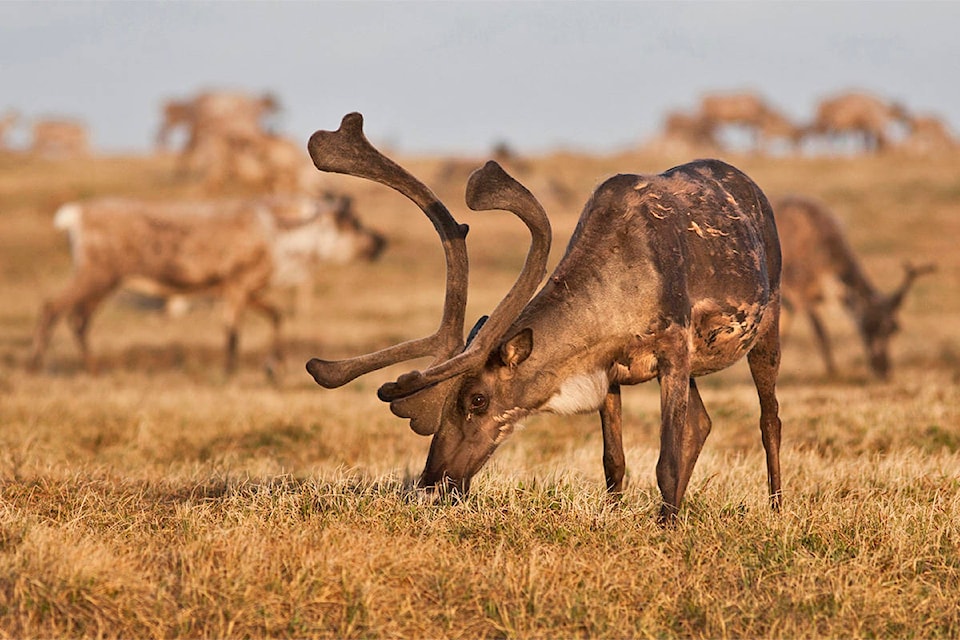U.S. officials did not consult with Vuntut Gwitchin First Nation when drafting a development plan for the Arctic National Wildlife Refuge (ANWR), the First Nation says in a formal submission obtained by the News.
Instead, the process was “rushed.”
“The Bureau of Land Management (BLM) did not provide reasonable opportunity for Vuntut Gwitchin First Nation to participate at public meetings during the scoping and draft EIS stages,” despite requests to hold hearings in Canada, the submission says.
This is in contravention of an international treaty signed between the two countries in 1987 that centres on preserving the Porcupine caribou herd, it suggests.
The submission was entered on March 13, the final day to comment on the draft environmental impact statement (EIS) that seeks to possibly open up a portion of ANWR to the oil and gas industry. The First Nation’s main concern deals with the fate of the caribou herd, which the Vuntut Gwitchin’s culture and, to a degree, economy depend on.
“A threat to the health of the Porcupine caribou herd is a threat to Vuntut Gwich’in’s physical, cultural and spiritual survival,” the submission says.
It says the First Nation uses the caribou most compared to other groups.
While not First Nations-specific, the draft EIS says that from 1992 to 1994 Canadians accounted for 85 per cent of the harvest.
Chief Dana Tizya-Tramm did not respond to requests for comment.
The First Nation lists a series of demands for the BLM to make good on, including re-opening the public comment period, extending it by 60 days and hosting meetings in Old Crow and other Canadian communities. It also requests that a public subsistence hearing be scheduled and that all consultation requirements are checked off.
The approach of the submission is similar to the Yukon government’s response to the U.S. plan. The First Nation, too, calls for a supplemental draft EIS because of alleged deficiencies.
“We conclude the draft EIS is so deficient and its approach to the impacts analysis is so deeply flawed the BLM must revise and reissue the draft EIS for public review if it is to move forward with an inclusive and transparent regulatory process,” the submission says, adding that “significant concerns” the First Nation has raised were not reflected in it or the scoping report, which came before the proposed development plan.
The Yukon government said in its formal response that the draft EIS is “silent on mitigations for subsistence users.”
There are four options in the draft EIS that provide varying degrees of protection for the herd.
Two involve providing lease sales for the entire program area, roughly 1.5 million acres. The remaining options say portions of the coastal plain would be off limits to oil and gas interests. No surface occupancy, a prohibition on all or some surface disturbances, would apply to each option within certain areas within the coastal plain, also referred to as 1002.
Vuntut Gwitchin First Nation is a proponent of a “no action” alternative.
This option, however, appears to be useless.
In December, when the draft EIS was published, Joe Balash, assistant secretary for land and minerals at the U.S. Department of the Interior, which oversees the BLM, suggested that not opening part of the refuge to development wouldn’t comply with legislation.
“Realistically, Congress has told us to have this sale,” he had said. “Practically speaking, we will be moving forward here and implementing the law.”
According to draft EIS, Vuntut Gwitchin is most likely to be the recipient of “potential indirect impacts due to their proximity and reliance” on the herd.
But the BLM doesn’t issue any information about the community, its deep relationship with the caribou or traditional knowledge, “a problem exacerbated by the lack of public meetings in Old Crow, Yukon or direct consultation with the Vuntut Gwitchin First Nation,” the First Nation’s submission says.
Determining cumulative impacts on the First Nation as a result of potential development are spotty, it continues.
“There is no analysis of past, present or future impacts on the herd’s size, migrations, range, habitat quality, productivity. …”
While cultural ties to the Porcupine caribou are laid out, so is the animal’s place in the First Nation’s economy, “which is based on traditional subsistence harvesting and wage-based activities.”
“There is no replacement for the Porcupine caribou should the population fall below sustainable harvest rates,” the submission says.
For contrast, it states that, in 2010, a family of four in Old crow paid 320 per cent more for food than those in Edmonton.
The BLM, the submission says, “failed to meaningfully analyze the complexity of subsistence resources and practices, or determine how oil and gas activity on the coastal plain will impact cultural and traditional values, or the socio-economic viability of remote, northern Indigenous communities.”
While subsistence impacts are assessed in U.S. communities, Canadian ones are excluded, it says (the U.S. determines these issues under the Alaska National Interest Lands Conservation Act).
In December 2017, ANWR’s coastal plain was opened up to the possibility of oil and gas leases when the Trump administration inserted a provision in to the Tax Cuts and Jobs Act.
The U.S. legislation stipulates that one lease must be issued in four years and that no fewer than two lease sales, each to include at least 400,000 acres with the highest potential of hydrocarbons, must occur by 2024.
A final EIS will likely be released in early summer. The first lease sale is expected to occur this year.
Contact Julien Gignac at julien.gignac@yukon-news.com
